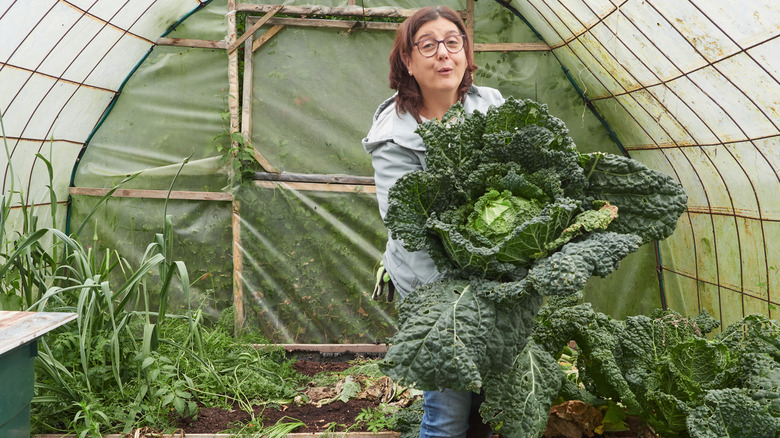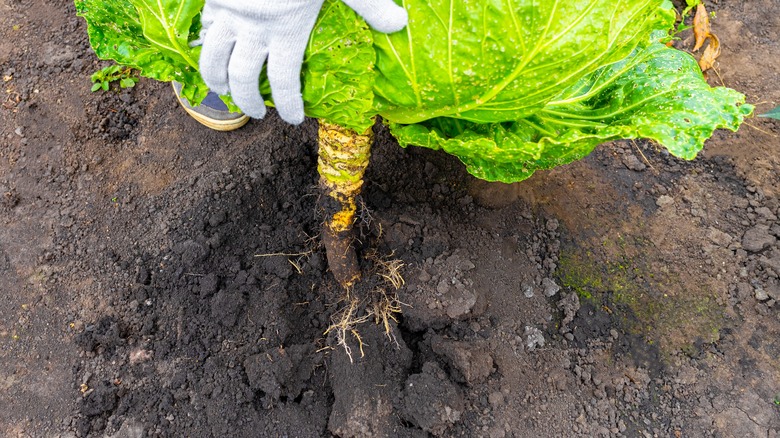This Simple Trick Makes Harvesting Cabbage So Much Easier
Passionate about brassicas? Then you probably already know that cabbage is a cool season harvest vegetable. In fact, some cabbage varieties are among the vegetables to plant in winter for an early pop of spring color. You know when to pluck these tasty rounds from the ground, but do you know how? Harvesting ready-to-eat cabbage couldn't be easier. The trick is to cup your hands under the well-formed head, twist or wiggle the head and stem a little to loosen the roots, and lift the entire plant from the ground, pulling it toward your body in a rapid, sweeping motion.
You have your garden knife at the ready, you say? We get it! Harvesting cabbage by cutting the head off close to where it meets the stem and above the outermost leaves with a sharp, clean knife is perfectly acceptable. In fact, many garden gurus recommend this as a method because some secondary, albeit far smaller, cabbage heads may pop up from the plant parts left in the ground. Who doesn't want more for the dinner table? If, however, you split the stalk while hacking out the original head, you're unlikely to see this additional harvest. It also only works with early maturing cultivars. Plus, with so much healthy growth removed, the remaining plant is more vulnerable to disease and pests. Cabbage moth caterpillars, for example, love to hide in the remains of a recently harvested cabbage plant, and root maggots, as their name suggests, munch on the roots.
How to pull up cabbage plant, roots and all
Pulling the entire plant from the ground — head, roots, stem, and all — has some distinct advantages, especially if you're satisfied with a single hearty head. Similar to thinning seedlings for a bigger harvest in your veggie garden, pulling your cabbages instead of leaving the leftovers in the ground gives you room to plant more crops. In fact, pulling is the traditional way to harvest brassicas since cellar-stored plants keep longer when intact. Some experts suggest you can even replant overwintered roots come spring for a second crop. Pulling and then removing the roots is also the preferred method for large-scale mechanical harvesting.
If your soil is nice and crumbly, pulling the cabbage out whole shouldn't be too difficult. Nestle your hands between the head and the biggest leaves, bend your knees slightly, and pull the entire plant upwards toward you. If it won't budge, use a garden fork to break up the soil around the base of the plant and try again. You can also wiggle or twist the plant as you pull. Once the plant is out of the ground, remove some of the largest leaves and use a knife to cut the head from the stem. Make sure you're only pulling plants with large, firm heads, a clear indicator they're mature and ready to harvest, and do so in the morning or evening, when it's cool. Pulled cabbages wilt quickly in the sun and warm weather.
The twist-and-pull has other meanings in cabbage growing lore
We'd be remiss if we didn't tell you there's a downside to this method, though it mostly affects those growing in raised beds or practicing no-till gardening. When you pull an entire plant out of the ground, especially one as rotund as a cabbage, you displace the soil and disrupt the mini ecosystem of other plant roots and teeny critters that's formed around it. If you're worried about ruining your lovingly tended garden beds, try this space-saving DIY you should know before planting, which involves growing the immense leafy greens in hanging planters or individual containers. You can pull to your heart's content!
Also, don't get the twist-and-pull method confused with another rotation-related cabbage-growing trick. Some garden experts recommend twisting the cabbage stem 180 degrees, bending it, or severing some of the roots with a trowel to stop the head from maturing too much. Why does this matter? Over-ripe cabbage heads are prone to splitting — that is, the firm, dense head breaks apart to reveal the bundle of leaves hidden inside. Once open, the head quickly turns inedible. Splitting usually occurs when drought conditions are chased by lots of rain or watering. An extra-thirsty cabbage tries to drink as much water as possible, bloating its stem, leaves, and head. The twisting motion breaks the roots, cutting off much of the cabbage's water supply.

